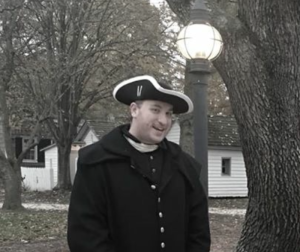Lewes tours showcase revolutionary roots and beyond
Visitors who find themselves on the corner of Second and Mulberry streets in downtown Lewes may not realize they are encompassed by history.
Across the street is a rambling Victorian mansion once owned by a river pilot; a few doors down is the 225-year-old home of former Delaware Gov. Daniel Rodney; and right on the corner sits the Ryves Holt House, dating to 1686 and the oldest building in Delaware still on its original foundation.
Historic Lewes Director of Education J. Marcos Salaverria finds it fascinating. “It’s a rare thing to be able to stand on one spot and be surrounded by three centuries of history,” he said.
Historic Lewes offers walking tours that focus on four distinct aspects of Lewes history and how they all tie together. Each tour has been updated and enhanced with additional information as research continues, using the organization’s artifact collections and historical document archives.
The View into the Past tour, held at 5 p.m. each Thursday starting May 8, features homes from Lewes’ Revolutionary War period, when the First Town in the First State served as the Sussex County seat.
“This is not a traditional architectural tour, but a look into how Lewes has grown organically,” Salaverria said. He noted that moving houses to new lots or adding them onto existing homes was a common practice, even into the 20th century. One house on the tour was built in 1720 on the banks of Lewes Creek – now the Lewes-Rehoboth Canal – then moved to town, then moved again in the early 1960s to its current location near the corner of Third and Mulberry streets.
On Tuesdays at 4 p.m., beginning in June, The Voices Heard tour tells the truths of African American Lewestowners’ experience. Participants are led on a walk through the once-segregated neighborhood of Chamomile, anchored by St. George AME Church. In the federal census of 1800, about 31 percent of Lewes residents were free Blacks, 17 percent were enslaved Blacks, and 51 percent were white. “This tour draws attention to this disappearing community,” Salaverria said, because today the town’s non-white population is about 6 percent of residents.
On Wednesday and Sunday evenings at 6 p.m. through October, it’s time for the Lewes Legends tour. “After a hot day on the beach, you might be chilled to hear of some of the nefarious exploits of residents of Lewes’s past, some who might still remain,” Salaverria said. “It’s a great chance to walk the streets of Lewes after hours.”
Finally, the Highlights tour, offered Thursday, Friday and Saturday at 11 a.m., is a 45–60-minute experience that introduces visitors to some of Lewes’s most well-remembered families and defining historical moments. “It’s an ideal introduction to some of Lewes’s most storied families and pivotal events,” said Salaverria.
Lewes was founded by the Dutch in 1631, but, as Salaverria said, “Some visitors are shocked to hear that we have only one Dutch-style building.” That is the Zwaanendael Museum, built in the 1930s to celebrate the town’s 300th anniversary.
Visitors will learn about Lewes' role in the American Revolution, its bombardment during the War of 1812 and daily life after 1683, when Lewes became an English-controlled colony. In those days, Salaverria said, “You would have seen international visitors, mostly from Europe. Lewes was a crucial stop for ships heading to Philadelphia,” because the aid of a pilot was required to navigate the passage of the Delaware Bay and River.
“With all the tours on offer, the hope is that people will realize that Lewes is not a beach town, but a place with a rich history that just happens to have a beach,” he said.
Full tour information and booking details are available at historiclewes.org/tours.















































